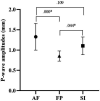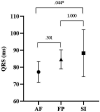Evaluation of electrocardiographic parameters in amputee football players
- PMID: 37554132
- PMCID: PMC10405824
- DOI: 10.3389/fpsyg.2023.1189712
Evaluation of electrocardiographic parameters in amputee football players
Abstract
Objective: The present study aimed to compare electrocardiographic (ECG) parameters of amputee football players (AF) with football players without disability (FP) and sedentary individuals without disability (SI).
Methods: A total of 32 participants (AF = 9, FP = 11, SI = 12) were included in the study. ECG parameters including P-wave amplitude, P-wave duration, PR interval, QRS duration, RR interval, QT interval, corrected-QT interval (QTc), ST segment duration, Tp-e duration, Tp-e/QT and Tp-e/QTc ratios were assessed in all the study participants by using a 12-lead ECG device. OneWay ANOVA Test was used for statistical analysis.
Results: Of all ECG parameters, P-wave amplitude and QTc were significantly higher in the AF group in comparison to FP and SI groups. QRS duration was found to be lower in the AF group when compared to FP and SI groups. Myocardial repolarization parameters including Tp-e duration, Tp-e/QT and Tp-e/QTc ratios were similar between groups, as were other parameters such as P-wave duration, PR interval, RR interval, QRS duration and QT interval.
Conclusion: It was found that some ECG parameters of amputee football players differ from those with non-disabled players and non-disabled sedentary individuals. These different parameters were within normal limits.
Keywords: amputation; cardiac function; disability; electrocardiography; football.
Copyright © 2023 Kurtoğlu, Kurtoğlu, Akgümüş, Çar, Eken, Sârbu, Ciongradi, Alexe and Candussi.
Conflict of interest statement
The authors declare that the research was conducted in the absence of any commercial or financial relationships that could be construed as a potential conflict of interest.
Figures
References
-
- Bakalim G. (1969). Causes of death in a series of 4738 Finnish war amputees. Artif. Limbs 13, 27–36. PMID: - PubMed
-
- Carmona Puerta R., Lorenzo Martínez E., Rabassa López-Calleja M. A., Padrón Peña G., Castro Torres Y., Cruz Elizundia J. M., et al. . (2021). New Parameter of the Second Half of the P-Wave, P-Wave Duration, and Atrial Conduction Times Predict Atrial Fibrillation during Electrophysiological Studies. Med. Princ. Pract. 30, 462–469. doi: 10.1159/000518262, PMID: - DOI - PMC - PubMed
-
- Castro Hevia J., Antzelevitch C., Tornés Bárzaga F., Dorantes Sánchez M., Dorticós Balea F., Zayas Molina R., et al. . (2006). Tpeak-Tend and Tpeak-Tend Dispersion as Risk Factors for Ventricular Tachycardia/Ventricular Fibrillation in Patients With the Brugada Syndrome. J. Am. Coll. Cardiol. 47, 1828–1834. doi: 10.1016/j.jacc.2005.12.049 - DOI - PMC - PubMed
LinkOut - more resources
Full Text Sources
Research Materials




